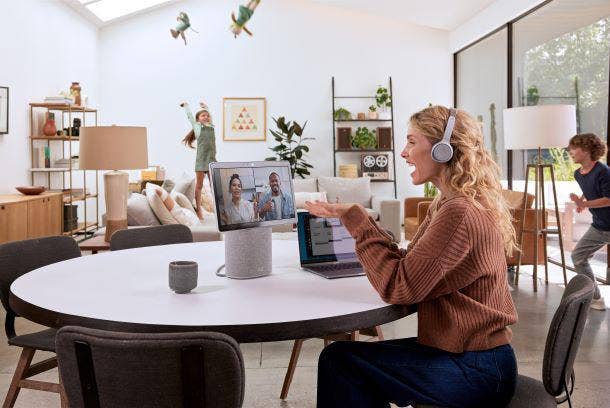Cisco Webex Investment ‘Thrills’ Partners Targeting Hybrid Work Opportunities
The tech giant continues to take aim at its collaboration competition by continuously innovating and bolstering its Webex collaboration platform with more than 1,000 new features and capabilities over the last 12 months in an investment that Cisco partners applaud.

Cisco Systems is addressing the hybrid work trend in the best way it knows how: by strengthening its popular Webex collaboration to the tune of more than 1,000 new features and capabilities over the last 12 months.
Sixty-four percent of employees believe the ability to work remotely instead of coming into an office directly affects whether they stay or leave a job, according to Cisco’s Hybrid Work Index, a report that the company plans on releasing quarterly. Many businesses agree that the future of work will be hybrid and are adjusting their policies and plans to reflect that, Jeetu Patel, Cisco’s executive vice president and general manager, security and collaboration business units, told CRN.
“We have this tremendous opportunity in collaboration that continues to stay in front of us,” Patel said. “This mixed mode of working will actually be harder to adjust to … in order for organizations to get the best talent, they‘re going to need to make sure they can provide a level of inclusivity so that everyone feels like they are equally participating, that they have a voice in the meeting, and that they’re feeling supported as employees.”
Partners are “thrilled” to see constant innovation on the Webex platform, proving that Cisco isn’t resting on its laurels, said Lane Irvine, network business solutions director for Long View Systems, a Calgary, Alberta-based Cisco partner. Zoom may have become a household videoconferencing name for consumers, but Webex is the name in the corporate world, he added.
“I love that Cisco hasn’t sat back with Webex and said: ’You’ve got the tool, just use it.’ The features and the engagement that they’ve added has really upped the game, and I think provides better integration and connections with [tools] like Microsoft Teams and room video systems,” Irvine said.
Cisco during its second annual WebexOne event on Tuesday, Cisco launched a slew of new features and updates to its collaboration platform, including a Voice Equalizer feature and third-party interoperability with the likes of Microsoft Teams and Zoom, and even a Hologram offering, which is still in preview. The company also introduced a new desk camera option for home workers, Webex Desk Mini, and a new headset made in collaboration with sound company Bang and Olufsen.
Cisco since 2020 closed five acquisitions to boost its collaboration platform, strengthen its cloud contact center chops, and smarten up its camera technology. The company in August 2020 bought BabbleLabs technology to distinguish human speech from unwanted noise, and in July, acquired Swedish video analytics provider Modcam.
San Jose, Calif.-based Cisco in May closed on its deal for audience interaction technology specialist Slido, Socio Labs for its live events technology in July, and contact center-as-a-service (CCaaS) firm IMImobile PLC in February. All of these acquisitions have been integrated into Webex within 45 days of the deal closing, Patel said.
Cisco’s continuing investment into the Webex platform is a welcome sight for partners as competition heats up in the collaboration market, said Joe Berger, senior director of World Wide Technology’s (WWT) digital workspace practice. “You’ve seen Microsoft get really good at Teams and some of the hardware vendors like Poly really amp up their product development innovation. Cisco is keeping up with that, while also looking further ahead and innovate in newer places,” he said.
The long-term hybrid work trend opens a massive market opportunity for the channel, Berger said. “We saw people doing quick fixes in early 2020, and now, [they] have to have a forever hybrid work model. [It‘s about] how do you make sure you’re set up at full scale and ready to go with the right tools in place, the right security postures, and understanding of your end user requirements,” he said.
The “forever hybrid” model means video everywhere — not just in a couple of conference rooms, Berger said. Cisco’s Hybrid Work Index found that 98 percent of meeting happening today have at least one person joining remotely. That’s why WWT is outfitting its clients with video solutions that prioritize inclusivity for users both in the office and those working remotely. Cisco’s Voice Equalizer and People Focus features will help give a feeling of equality to meeting attendees, he added. “That’s a pretty unique feature that we’re pretty excited to come out.”
Video everywhere also includes hardware. Cisco’s new Desk Mini is a smaller camera option for users that don’t have much desk real estate in their home offices or need to move around throughout their homes to take meetings. “The laptop camera just doesn’t quite cut it if you’re going to be on video calls all day,” Berger said.
The hybrid work trend pointed to a need for interoperability as users adopted new collaboration and communication tools. Cisco at WebexOne announced that the latest version of the Webex Room operating system supports interoperability with Zoom, Microsoft Teams and Google Meetings to support a more open meeting experience.
“Cisco makes great, beautiful hardware,” Berger said. “Now that fact that it works with other platforms just makes it that more compelling.”
More than 61 million meetings take place globally every month on Cisco Webex, which includes remote and in-office meeting attendees, the company said.